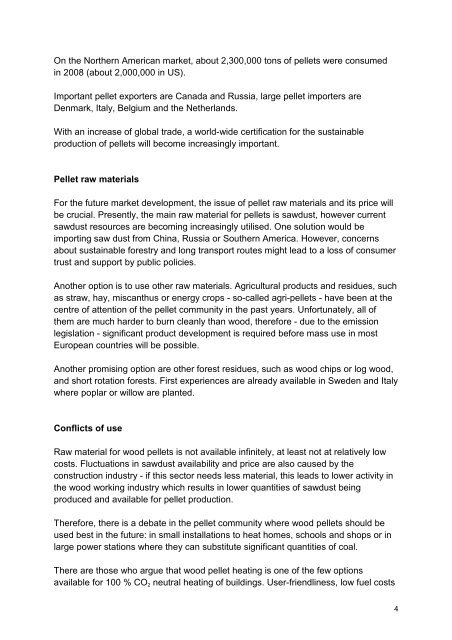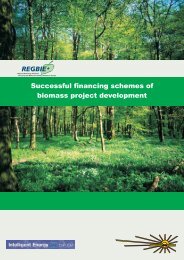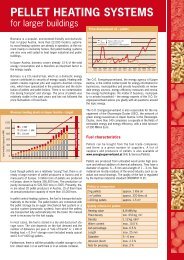Key Issues for Wood Pellet Market Development
Key Issues for Wood Pellet Market Development
Key Issues for Wood Pellet Market Development
You also want an ePaper? Increase the reach of your titles
YUMPU automatically turns print PDFs into web optimized ePapers that Google loves.
On the Northern American market, about 2,300,000 tons of pellets were consumed<br />
in 2008 (about 2,000,000 in US).<br />
Important pellet exporters are Canada and Russia, large pellet importers are<br />
Denmark, Italy, Belgium and the Netherlands.<br />
With an increase of global trade, a world-wide certification <strong>for</strong> the sustainable<br />
production of pellets will become increasingly important.<br />
<strong>Pellet</strong> raw materials<br />
For the future market development, the issue of pellet raw materials and its price will<br />
be crucial. Presently, the main raw material <strong>for</strong> pellets is sawdust, however current<br />
sawdust resources are becoming increasingly utilised. One solution would be<br />
importing saw dust from China, Russia or Southern America. However, concerns<br />
about sustainable <strong>for</strong>estry and long transport routes might lead to a loss of consumer<br />
trust and support by public policies.<br />
Another option is to use other raw materials. Agricultural products and residues, such<br />
as straw, hay, miscanthus or energy crops - so-called agri-pellets - have been at the<br />
centre of attention of the pellet community in the past years. Un<strong>for</strong>tunately, all of<br />
them are much harder to burn cleanly than wood, there<strong>for</strong>e - due to the emission<br />
legislation - significant product development is required be<strong>for</strong>e mass use in most<br />
European countries will be possible.<br />
Another promising option are other <strong>for</strong>est residues, such as wood chips or log wood,<br />
and short rotation <strong>for</strong>ests. First experiences are already available in Sweden and Italy<br />
where poplar or willow are planted.<br />
Conflicts of use<br />
Raw material <strong>for</strong> wood pellets is not available infinitely, at least not at relatively low<br />
costs. Fluctuations in sawdust availability and price are also caused by the<br />
construction industry - if this sector needs less material, this leads to lower activity in<br />
the wood working industry which results in lower quantities of sawdust being<br />
produced and available <strong>for</strong> pellet production.<br />
There<strong>for</strong>e, there is a debate in the pellet community where wood pellets should be<br />
used best in the future: in small installations to heat homes, schools and shops or in<br />
large power stations where they can substitute significant quantities of coal.<br />
There are those who argue that wood pellet heating is one of the few options<br />
available <strong>for</strong> 100 % CO 2 neutral heating of buildings. User-friendliness, low fuel costs<br />
4
















